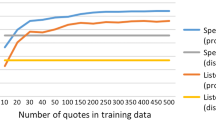Abstract
The dramatic text features dialogue as communication among characters for the benefit of the reader or audience. Computer analysis of selected parameters in the clearly defined rhetorical unit that is dialogue can test hypotheses, confirm intuitive criticism, and help discover structural, thematic, and discursive patterns that even close reading may not detect. This study describes approaches to the dialogue of a well known contemporary Spanish play that are neither time-consuming nor labor-intensive. Ready-made software can produce data and graphs for dialogal structuring, repeat rates of semantic fields, distribution and density of theme words and imagery, interaction of characters, and idiolects.
Similar content being viewed by others
References
Bakhtin, M. The Dialogic Imagination: Four Essays. Tr. C. Emerson and M. Holquist. Austin: University of Texas, 1981.
Beatie, Bruce A. “Measurement and the Study of Literature.” Computers and the Humanities, 13 (1979), pp. 185–94.
Buero Vallejo, Antonio. En la ardiente oscuridad. Madrid: Espasa-Calpe, 1977.
Burrows, J. F. Computation Into Criticism. A Study of Jane Austen's Novels and an Experiment in Method. Oxford: Clarendon, 1987.
Carter, Ronald. “Poetry and Conversation.” In Language, Discourse and Literature. Eds. Ronald Carter and Paul Simpson. London: Unwin Hyman, 1989, pp. 58–74.
Electronic Text Corporation. WordCruncher (Version 4.30). Provo, UT, 1989.
Forys, Marsha. Antonio Buero Vallejo and Alfonso Sastre. An Annotated Bibliography. Metuchen: Scarecrow, 1988.
Fortier, Paul A. “Some Statistics of Themes in the French Novel.” Computers and the Humanities, 23, 4–5 (1989), pp. 293–99.
Fowler, Roger. “Polyphony in Hard Times.” Language, Discourse and Literature. London: Unwin Hyman, 1989, pp. 76–93.
Garcia Hoz, Victor. Vocabulario usual, vocabulario común y vocabulario fundamental. Madrid: Instituto “San José de Calasanz,” 1953.
Halsey, Martha T. Antonio Buero Vallejo. NY: Twayne, 1973.
Hyde, James F. C., Jr. “From a Blind Person's Viewpoint.” The Washington Post. December 19, 1989, Health 14.
Hubka, Karel P. “Scenic Dominance, Motif and Conflict in the Topological Structures of the New Comedy, part 2.” ALLC Bulletin, 13, 3 (1985), pp. 61–66.
Ide, Nancy M. “Image Patterns and the Structure of William Blake's The Four Zoas.” Blake: An Illustrated Quarterly, 20 (1989), pp. 125–33.
Ide, Nancy M. “Meaning and Method: Computer-Assisted Analysis of Blake.” In Literary Computing and Literary Criticism. Ed. Rosanne G. Potter. Philadelphia: 1989, University of Pennsylvania Press pp. 123–41.
Ide, Nancy M. “A Statistical Measure of Theme and Structure.” Computers and the Humanities, 23, 4–5 (1989), pp. 277–82.
Info World. Dec. 18, 1989, p. 52.
Lancaster, Ian and Lidio Presutti. MTAS (Micro Text-Analysis System), Toronto: University of Toronto, 1988.
Nicholas, Robert L. The Tragic Stages of Antonio Buero Vallejo. Chapel Hill: University of North Carolina, 1972.
Oakman, Robert L. Computer Methods for Literary Research. Columbia, SC: University of South Carolina, 1980.
Personal Computing. Jan. 1990, p. 26.
Potter, Rosanne G. “From Literary Output to Literary Criticism: Discovering Shaw's Rhetoric.” Computers and the Humanities, 23, 4–5 (1989a), pp. 333–40.
Potter, Rosanne G. “OCP and Oscar Wilde's Dramatic Vocabulary.” The Dynamic Text (abstracts). Toronto: University of Toronto, 1989b, pp. 59–62.
Potter, Rosanne G. “Changes in Shaw's Dramatic Rhetoric: Mrs. Warren's Profession, Major Barbara, and Heartbreak House.” In Literary Computing and Literary Criticism. Ed. Rosanne G. Potter. Philadelphia: University of Pennsylvania Press, 1989c, pp. 225–58.
Pratt, Mary Louise. Toward a Speech Act Theory of Discourse, Bloomington: Indiana University, 1977.
Reimer, Stephen R. LitStats. Edmonton, AL, 1989.
Searle, John R. Intentionality. An Essay in the Philosophy of Mind. Cambridge: Cambridge University Press, 1985.
Short, Mick. “Discourse Analysis and the Analysis of Drama.” In Language, Discourse and Literature. Eds. Ronald Carter and Paul Simpson. London: Unwin Hyman, 1989, pp. 139–68.
Simonton, Dean K. “Shakespeare's Plays and Sonnets: Correlates of Differential Greatness.” In Literary Discourse. Ed. Halász, Lásló. Berlin: De Gruyter, 1987, pp. 193–200.
Simpson, Paul. “Politeness Phenomena in Ionesco's The Lesson.” In Language, Discourse and Literature. Eds. Ronald Carter and Paul Simpson. London: Unwin Hyman, 1989, pp. 171–93.
Author information
Authors and Affiliations
Rights and permissions
About this article
Cite this article
Irizarry, E. Some approaches to computer analysis of dialogue in theater: Buero Vallejo's En la ardiente oscuridad . Comput Hum 25, 15–25 (1991). https://doi.org/10.1007/BF00054286
Issue Date:
DOI: https://doi.org/10.1007/BF00054286




